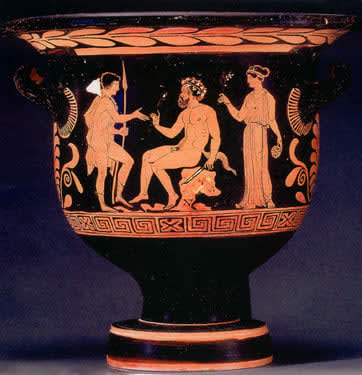Apulian Red-Figure Bell Krater, 380 BCE - 365 BCE
Terracotta
height 33.3 cm
height 13 1/8 in
height 13 1/8 in
X.0083
Further images
The Greek colonies of Southern Italy, known in antiquity as Magna Graecia, or “Greater Greece,” were marked by their initial allegiance to the ceramic styles of the Attic mainland. However,...
The Greek colonies of Southern Italy, known in antiquity as Magna Graecia, or “Greater Greece,” were marked by their initial allegiance to the ceramic styles of the Attic mainland. However, over the years, native traditions and innovations heavily influenced the works of Magna Graecian potters. Unorthodox forms and painting-styles were seamlessly merged with the standard Greek style, creating distinctive works of art unique to the Hellenistic world.
Kraters are a group of vessels with wide mouths, a narrow, footed base, and handles. Foremost among the different types of kraters is the bell krater, so-called because it emits a pleasant ringing sound not unlike a bell when gently struck with a finger. Kraters were an essential piece of equipment in the symposium, a type of diner banquet immortalized by Plato where drinking and revelry were the encouraged activities. After the food was consumed, the group of men retired to a special room with a floor that sloped into a central drain (to facilitate cleaning the morning after) where drinks were served and female consorts entertained with music and dancing. Before the wine was served, it was first diluted with water inside a krater such as this one.
This gorgeous Apulian bell krater is decorated with two red-figure painted scenes. On the front, a satyr is seated on a rock, wearing a wreath in his hair, seemingly passing a staff to a young man who stands in front of him with a prominent white cap resting off of his head. Behind the satyr, a woman stands wearing a belted chiton and holding a branch. On the reverse, three men stand together, all clad in himation, the two on the sides holding canes. Might they be engaged a political or philosophical discussion, the type of discourse that was common at symposia (that is, before the wine took effect and these reserved men transformed into the untamed satyr). Being that kraters were so integral to the joys of the symposium, it is only natural that they are traditionally decorated with scenes of revelry and merriment that often echo the parties themselves, as is the case with this splendid example.
Kraters are a group of vessels with wide mouths, a narrow, footed base, and handles. Foremost among the different types of kraters is the bell krater, so-called because it emits a pleasant ringing sound not unlike a bell when gently struck with a finger. Kraters were an essential piece of equipment in the symposium, a type of diner banquet immortalized by Plato where drinking and revelry were the encouraged activities. After the food was consumed, the group of men retired to a special room with a floor that sloped into a central drain (to facilitate cleaning the morning after) where drinks were served and female consorts entertained with music and dancing. Before the wine was served, it was first diluted with water inside a krater such as this one.
This gorgeous Apulian bell krater is decorated with two red-figure painted scenes. On the front, a satyr is seated on a rock, wearing a wreath in his hair, seemingly passing a staff to a young man who stands in front of him with a prominent white cap resting off of his head. Behind the satyr, a woman stands wearing a belted chiton and holding a branch. On the reverse, three men stand together, all clad in himation, the two on the sides holding canes. Might they be engaged a political or philosophical discussion, the type of discourse that was common at symposia (that is, before the wine took effect and these reserved men transformed into the untamed satyr). Being that kraters were so integral to the joys of the symposium, it is only natural that they are traditionally decorated with scenes of revelry and merriment that often echo the parties themselves, as is the case with this splendid example.





